Stablecoins are all the rage, but can Bitcoin still fulfill the currency's "payment dream"?
Original Article Title: "Stablecoins: Genius Act Paves Way for Bitcoin to Dominate Global Infrastructure"
Original Article Author: Juan Galt
Original Article Source: BitCoin Magazine
Original Article Translation: AididiaoJP, Foresight News
As the "GENIUS Act" solidifies the status of US Treasury-backed stablecoins, Bitcoin's decentralized network positions it as a more suitable blockchain for global adoption and to address the diminishing demand for US bonds in a multipolar world.
With the world transitioning from a US-dominated unipolar order to a multipolar framework led by BRICS nations, the US dollar is under unprecedented pressure due to declining bond demand and rising debt costs. The "GENIUS Act" passed in July 2025 signifies a bold strategic move by the US to address this scenario by legislatively recognizing US Treasury-backed stablecoins, unlocking massive overseas demand for US bonds.
The blockchain hosting these stablecoins will shape the global economy for decades to come. Bitcoin, with its unparalleled decentralization, Lightning Network privacy, and robust security, emerges as the superior choice to drive this digital dollar revolution, ensuring lower conversion costs when the fiat inevitably declines. This article discusses why the dollar must and will be digitized through blockchain and why Bitcoin must be on its operational track for the US economy to achieve a soft landing from its global imperial peak.
The End of a Unipolar World
The world is transitioning from a unipolar world order (where the US was the sole superpower capable of influencing markets and dominating global conflicts) to a multipolar world, wherein Eastern alliances can self-organize free from US foreign policy dictates. This Eastern alliance, known as the BRICS nations, comprises major countries like Brazil, Russia, China, and India. The rise of BRICS nations inevitably leads to geopolitical realignment, posing a challenge to the dollar's hegemony.
Several seemingly isolated data points indicate this reorganization of the world order, such as the US military alliance with Saudi Arabia. The US no longer upholds the Petrodollar Pact, which mandated Saudi oil to be sold only in dollars in exchange for US military defense of the region. The Petrodollar strategy has been a primary driver of dollar demand, crucial to the US economic prowess since the 1970s, but has effectively ended in recent years, at least since the start of the Ukraine conflict, as Saudi Arabia began accepting currencies other than the dollar for oil-related trades.
The Weakness of the U.S. Bond Market
Another key data point in the geopolitical upheaval of the world order is the weakness of the U.S. bond market, with increasing market skepticism about the long-term creditworthiness of the U.S. government. Some are concerned about internal political instability in the country, while others doubt whether the current government structure can adapt to the rapidly changing high-tech world and the rise of emerging economies.
Elon Musk is said to be one of the skeptics. Musk recently spent months working with the Trump administration in an attempt to reorganize the federal government and the country's financial situation through the Department of Efficiency, but abruptly exited the political scene in May.
Musk shocked the internet recently when he appeared at a summit, saying, "I haven't been to Washington since May. The government is basically irredeemable. I appreciate David Sachs' noble efforts... But ultimately, if you look at our national debt... If AI and robots can't solve our national debt issue, we're screwed."

If even Musk cannot steer the U.S. government away from its financial woes, who can?
These doubts are reflected in the low demand for U.S. long-term bonds, resulting in the need to raise interest rates to attract investors. Today, the U.S. 30-year Treasury yield stands at 4.75%, the highest in 17 years. According to Reuters, demand for long-term bonds like the U.S. 30-year Treasury is also on the decline, with the 2025 auction demand being "disappointing."

The weakening demand for U.S. long-term bonds has significant implications for the U.S. economy. The U.S. Treasury must offer higher rates to attract investors, which in turn increases the interest payments the U.S. government must make on its debt. Today, the U.S. interest payments are nearing one trillion dollars annually, exceeding the entire national defense budget.

If the U.S. fails to find enough buyers for its future debt, it may struggle to pay its current bills and instead rely on the Federal Reserve to purchase this debt, expanding its balance sheet and money supply. While the effects are complex, this is likely to lead to dollar inflation, further harming the U.S. economy.
How Sanctions Have Devastated the Bond Market
Further undermining the U.S. bond market is the U.S.'s manipulation of its controlled bond market in 2022 to target Russia in response to its invasion of Ukraine. During Russia's invasion, the U.S. froze Russia's overseas national treasury reserves, which were intended to repay its bonds to Western investors. It is reported that to force Russia into default, the U.S. also began blocking Russia's attempts to repay all debt owed to foreign bondholders.
A female spokesperson from the US Treasury Department confirmed at the time that some payments were no longer allowed.
"Today is the deadline for Russia to make another debt payment," the spokesperson said.
"Starting today, the US Treasury Department will not allow any dollar debt payments from the Russian government's accounts at US financial institutions. Russia must choose between depleting its remaining dollar reserves or seeking new sources of revenue, or default."
The US effectively weaponized the bond market to confront Russia through its diplomatic policy sanction mechanism. However, sanctions are a double-edged sword: since then, foreign demand for US bonds has weakened as countries not aligned with US foreign policy seek to diversify risk. China has led this trend of moving away from US bonds, with its holdings peaking at over $1.25 trillion in 2013 and declining rapidly since the start of the Ukraine conflict, currently nearing $750 billion.

While this event showcased the destructive power of sanctions, it also severely damaged confidence in the bond market. Not only was Russia prevented from repaying its debt under the Biden administration sanctions, but it also harmed investors as collateral damage. Freezing of its foreign treasury reserves has shown the world that if you, as a sovereign nation, go against US foreign policy, all bets are off, including the bond market.
The Trump administration no longer made sanctions a primary strategy as they harmed the US financial sector and shifted to a tariff-based diplomatic policy approach. The effectiveness of these tariffs has been mixed. While the Trump administration touted record tax revenues and private sector infrastructure investment domestically, Eastern nations accelerated their cooperation through the BRICS alliance.
Stablecoin Strategy Handbook
While China has reduced its holdings of US bonds over the past decade, a new buyer has emerged, quickly rising to the top echelon. Tether, a fintech company born in the early days of Bitcoin, now holds $171 billion worth of US bonds, close to a quarter of China's holdings and surpassing most other countries.
Tether is the issuer of the most popular stablecoin USDT, with a circulating market cap of $171 billion. The company reported a $1 billion profit in the first quarter of 2025, with a simple yet outstanding business model: purchasing short-term US bonds, supporting the issuance of USDT tokens with a 1:1 peg, and pocketing the interest income from the US government. With 100 employees at the beginning of the year, Tether is reportedly one of the most profitable companies per capita in the world.

Circle, the issuer of USDC, is also the second most popular stablecoin in the market, holding nearly $50 billion worth of short-term treasury bonds. Stablecoins are used worldwide, especially in Latin America and developing countries, as a substitute for the local fiat currencies, which suffer from much worse inflation than the US dollar and are often subject to capital controls.
Today, stablecoin transaction volumes are no longer a niche, geeky financial toy; they have reached trillions of dollars. A Chainalysis report from 2025 stated: "From June 2024 to June 2025, USDT processed over $1 trillion monthly, peaking at $1.14 trillion in January 2025. Meanwhile, USDC trade volume fluctuated between $1.24 trillion and $3.29 trillion per month. These figures highlight Tether's and USDC's continued dominance in the cryptocurrency market infrastructure, especially in cross-border payments and institutional activities."

For example, according to a 2024 Chainalysis report focusing on Latin America, Latin America accounted for 9.1% of the total crypto value received between 2023 and 2024, with an annual usage growth rate ranging from 40% to 100%, with over 50% being stablecoins, demonstrating the strong demand for alternative currencies in the developing world.

The US needs a new demand for its bonds, and that demand exists in the form of a demand for the US dollar, as most of the world is trapped in fiat currencies far inferior to the US dollar. If the world were to move to a geopolitical structure that forces the dollar to compete on equal terms with all other fiat currencies, the dollar would still likely prevail. Despite its flaws, the US is still a superpower with incredible wealth, human capital, and economic potential, especially compared to many small countries with their shaky pesos.
Latin America has shown a deep desire for the dollar, but there is a supply issue as local nations resist traditional bank dollarization. Obtaining dollar-denominated accounts is not easy in many countries outside the US. Local banks are often under strict regulations and comply with the local governments, which also have an interest in maintaining their pesos. After all, the US is not the only government that knows how to print money and maintain the value of its currency.

Stablecoins address these two problems; they create demand for US bonds and can deliver dollar-denominated value to anyone anywhere in the world.
Stablecoins leverage the censorship-resistant nature of their underlying blockchain, a feature that local banks cannot provide. Therefore, by promoting stablecoins, the United States can tap into foreign markets that have not yet been reached, expand its demand and user base, and also export dollar inflation to countries that do not have a direct impact on US politics, which is a longstanding tradition in the dollar's history. From a strategic perspective, this sounds ideal for the United States and is a simple extension of how the dollar has operated for decades, just built on new financial technology.
The US government understands this opportunity. According to Chainalysis, "there has been a significant change in the stablecoin regulatory landscape over the past 12 months. While the US GENIUS Act has not yet come into effect, its passage has already driven strong institutional interest."
Why Stablecoins Should Go Beyond Bitcoin
The best way to ensure that Bitcoin moves the developing world away from mediocre fiat currencies is to ensure that the dollar uses Bitcoin as its operational rail. Every dollar stablecoin wallet should also be a Bitcoin wallet.
Critics of the Bitcoin dollar strategy would say that this goes against the libertarian roots of Bitcoin, which should replace the dollar rather than enhance it or bring it into the 21st century. However, this concern is largely US-centric. It is easy to criticize the dollar when you are paid in dollars and your bank account is denominated in dollars. It is easy to criticize it when a 2-8% inflation rate is your local currency. In too many countries outside the US, an annual 2-8% inflation rate is a blessing.
A large part of the world's population suffers from legal tender currencies that are much worse than the dollar, with inflation rates ranging from low double digits to triple digits, which is why stablecoins have been widely adopted in the third world. The developing world needs to get off this sinking ship first. Once they board a stable ship, they may start looking for ways to upgrade to a Bitcoin yacht.
Unfortunately, although most stablecoins initially started on Bitcoin, they do not operate on Bitcoin now, which has brought significant friction and risk to users. Today, most stablecoin transaction volume operates on the Tron blockchain, a centralized network run by Justin Sun on a few servers, making it an easy target for foreign governments who do not like the spread of dollar stablecoins within their borders.
Most blockchains that stablecoins rely on today are also entirely transparent. Public addresses serving as user accounts are publicly traceable, often linked by local exchanges to users' personal data and easily accessible by local governments. This is a leverage point foreign countries can use to counter the spread of dollar-denominated stablecoins.
Bitcoin does not have these infrastructure risks. Unlike Ethereum, Tron, Solana, etc., Bitcoin is highly decentralized, with tens of thousands of nodes around the world and a robust peer-to-peer network for transaction propagation, easily bypassing any bottleneck or obstruction. Its proof-of-work layer provides power separation that other proof-of-stake blockchains do not have. For example, even though Michael Saylor holds a significant amount of Bitcoin, 3% of the total supply, he does not have direct voting power in the network's consensus politics. This is different for Vitalik and Ethereum's proof-of-stake consensus or Justin Sun and Tron.
Additionally, the Lightning Network built on top of Bitcoin unlocks instant transaction settlement, benefiting from the security of the Bitcoin underlying blockchain. It also provides significant privacy for users because all Lightning Network transactions are designed to be off-chain and do not leave a trace on its public blockchain. This fundamental difference in payment methods allows users to have privacy when sending funds to others. This reduces the number of threat actors able to violate user privacy from anyone able to view the blockchain to a few oligarchs and tech companies, at worst.
Users can also run their own Lightning nodes locally and choose how to connect to the network, as many indeed do, keeping privacy and security in their hands. These features are not seen in most blockchains used for stablecoins today.
Compliance policies and even sanctions can still be applied to USD stablecoins, whose governance is anchored in Washington, using the same analytics and smart contract-based approach used today to prevent stablecoin criminal use. Fundamentally, a dollar-like asset cannot be decentralized since its design is centralized. However, if a significant portion of stablecoin value shifts through the Lightning Network, user privacy can also be upheld, protecting users in developing countries from organized crime or even their local government.
Ultimately, what users care about is transaction fees, the cost of moving funds; this is why Tron continues to dominate the market. However, with USDT launching on the Lightning Network, this situation may change soon. In a Bitcoin-dollar world order, the Bitcoin network will become the medium of exchange for the dollar, and in the foreseeable future, the dollar will remain the unit of account.
Can Bitcoin Handle All This?
Critics of this strategy are also concerned that the Bitcoin-dollar strategy could impact Bitcoin itself. They wonder if putting the dollar on top of Bitcoin will distort its underlying structure. Superpowers like the United States government may want to manipulate Bitcoin most obviously by forcing it to comply with sanctions requirements, something they theoretically can do at the proof-of-work layer.
However, as mentioned earlier, the sanctions regime can be said to have reached its peak, giving way to the era of tariffs, which attempts to control the flow of goods rather than the flow of funds. This post-Trump, post-Ukraine War shift in U.S. diplomatic policy has actually alleviated the pressure on Bitcoin.

As Western companies, such as BlackRock, and even the U.S. government, continue to treat Bitcoin as a long-term investment strategy, or as former President Trump put it, as a "strategic Bitcoin reserve," they are also beginning to align themselves with the success and survival of the Bitcoin network in the future. An attack on Bitcoin's anti-censorship feature would not only undermine their investment in the asset, but also weaken the network's ability to deliver stablecoins to the developing world.
In the Bitcoin-dollar world order, the most obvious compromise Bitcoin must make is to give up the unit of account dimension of money. This is bad news for many Bitcoin enthusiasts, and rightfully so. The unit of account is the ultimate goal of hyperbitcoinization, where many users already live today, calculating economic decisions based on the ultimate impact of their Bitcoin holdings in satoshis. However, for those who understand Bitcoin as the soundest money in history, nothing can truly take that away. In fact, the belief in Bitcoin as a store of value and medium of exchange will be strengthened by this Bitcoin-dollar strategy.
Sadly, in an attempt to make Bitcoin a ubiquitous unit of account like the dollar 16 years later, some people are realizing that in the medium term, the dollar and stablecoins are likely to fulfill that use case. Bitcoin payments will never disappear, companies led by Bitcoin enthusiasts will continue to rise, and should continue to accept Bitcoin as a form of payment to build their Bitcoin reserves. However, in the coming decades, stablecoins and the value measured in dollars are likely to dominate crypto trading.
Nothing Can Stop This Train
As the world continues to adapt to the rise of the East and the emergence of a multipolar world order, the United States may have to make difficult and crucial decisions to avoid a prolonged financial crisis. In theory, the U.S. could reduce spending, pivot, and restructure to become more efficient and competitive in the 21st century. The Trump administration is certainly attempting to do so, as evidenced by efforts such as the tariff regime and other related endeavors, which aim to bring manufacturing back to the U.S. and nurture local talent.
While a few miracles may be able to solve America's financial woes, such as science-fictional labor and intelligent automation, or even the Bitcoin-dollar strategy, ultimately, even putting the dollar on the blockchain will not change its fate: to become a collectible of history enthusiasts, a relic of an ancient empire suitable for museums and rediscovery.
The centralized design of the dollar and its reliance on U.S. politics ultimately seal its fate as a currency. However, if we are realistic, its demise may not be seen for 10, 50, or even 100 years. When that moment truly arrives, if history repeats itself, Bitcoin should be there on the rails, ready to clean up the mess and fulfill the prophecy of hyperbitcoinization.
Welcome to join the official BlockBeats community:
Telegram Subscription Group: https://t.me/theblockbeats
Telegram Discussion Group: https://t.me/BlockBeats_App
Official Twitter Account: https://twitter.com/BlockBeatsAsia


 Forum
Forum Finance
Finance
 Specials
Specials
 On-chain Eco
On-chain Eco
 Entry
Entry
 Podcasts
Podcasts
 Activities
Activities
 OPRR
OPRR








